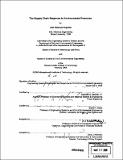| dc.contributor.advisor | David H. Marks. | en_US |
| dc.contributor.author | Paquette, Julie Rebecca | en_US |
| dc.contributor.other | Massachusetts Institute of Technology. Dept. of Civil and Environmental Engineering. | en_US |
| dc.date.accessioned | 2006-11-07T12:46:00Z | |
| dc.date.available | 2006-11-07T12:46:00Z | |
| dc.date.copyright | 2006 | en_US |
| dc.date.issued | 2006 | en_US |
| dc.identifier.uri | http://hdl.handle.net/1721.1/34530 | |
| dc.description | Thesis (S.M.)--Massachusetts Institute of Technology, Engineering Systems Division, Technology and Policy Program; and, Thesis (S.M.)--Massachusetts Institute of Technology, Dept. of Civil and Environmental Engineering, 2006. | en_US |
| dc.description | Includes bibliographical references (p. 131-135). | en_US |
| dc.description.abstract | Understanding and shaping the relationship between supply chain management and the natural environment is critical not only to human health and the environment, but to the future success of business. While the cumulative environmental impacts of industrial production are best addressed at the supply chain level, little research has connected the overall context of supply chain management, including the characteristics of environmental pressures and market drivers, to a general approach for developing operational supply chain processes that may deliver environmental and economic performance improvements. Findings from a series of semi-structured interviews indicate that there are four sources of environmental pressure currently affecting supply chain management in unique ways. These include regulations, customer demands, resources, and ethical responsibility. Corporations that are better able to identify and understand these impacts will be better positioned to address them strategically. A framework of supply chain environmental excellence is presented to illustrate how corporations may integrate environmental operating models, operational objectives, and new supply chain processes into a comprehensive corporate strategy. | en_US |
| dc.description.abstract | (cont.) A case study of the emergence of reverse supply chains within the electronics industry illustrates why supply chain processes should be developed in a context defined by environmental pressures and market drivers. As the electronics industry is faced with environmental pressure from evolving regulatory directives, liability concerns, and social responsibility demands, leading companies are researching and piloting reverse processes to varying extents. Findings from a second series of industry interviews reveal a number of regulatory, behavioral, and economic trends and challenges that collectively shape both strategic considerations for individual corporations and the overall supply chain capabilities of the industry. | en_US |
| dc.description.statementofresponsibility | by Julie Rebecca Paquette. | en_US |
| dc.format.extent | 135 p. | en_US |
| dc.format.extent | 8827500 bytes | |
| dc.format.extent | 8833126 bytes | |
| dc.format.mimetype | application/pdf | |
| dc.format.mimetype | application/pdf | |
| dc.language.iso | eng | en_US |
| dc.publisher | Massachusetts Institute of Technology | en_US |
| dc.rights | M.I.T. theses are protected by copyright. They may be viewed from this source for any purpose, but reproduction or distribution in any format is prohibited without written permission. See provided URL for inquiries about permission. | en_US |
| dc.rights.uri | http://dspace.mit.edu/handle/1721.1/7582 | |
| dc.subject | Technology and Policy Program. | en_US |
| dc.subject | Civil and Environmental Engineering. | en_US |
| dc.title | The supply chain response to environmental pressures | en_US |
| dc.type | Thesis | en_US |
| dc.description.degree | S.M. | en_US |
| dc.contributor.department | Massachusetts Institute of Technology. Department of Civil and Environmental Engineering | |
| dc.contributor.department | Massachusetts Institute of Technology. Engineering Systems Division | |
| dc.contributor.department | Technology and Policy Program | |
| dc.identifier.oclc | 70925356 | en_US |

